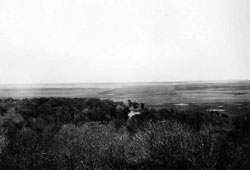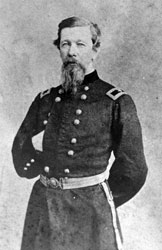Fort Mandan State Historic Site is temporarily closed for maintenance until further notice.
The stated reason for Pope’s decision to mount a major military campaign into Dakota Territory was his perception of a real danger of further Indian attacks on the still-nervous frontier. There also may have been other military, economic, and political considerations. The fur trade had reached the Missouri River by 1792, and a succession of traders, explorers, scientists, and soldiers had been expounding the many values and assets of the upper Missouri region. Enough information had been gathered to suggest that fortunes could be made. By 1861 land companies were already offering potential town sites and farms for sale in parts of the region. Steamboats and wagon trains, filled with miners, merchants, and families headed toward the gold fields of Montana and Idaho, and it was known that a transcontinental railroad would be crossing these plains once the Civil War ended. Military control of the territory would aid all these possibilities.

General Pope’s plan called for one army to march from Minnesota to the Devils Lake area, engaging the Sioux along the way, or pushing them westward towards the Missouri River. Meanwhile, a second army would advance northward along the Missouri, preventing escape across the river. Those caught between the two armies would either be captured or killed. The two armies were scheduled to rendezvous on July 25, 1863, at the Missouri River, where the field commanders could determine further action.

Sibley, who had displayed outstanding leadership as a colonel of volunteers during the conflict, was appointed to lead the Minnesota arm of the joint campaign. He was a veteran fur trader and knew the Dakota people well. As a former governor of Minnesota, General Sibley was well known and respected. General Alfred Sully, a West Point graduate experienced in Indian campaigns, was eventually chosen to command the second army.
Address:
612 East Boulevard Ave.
Bismarck, North Dakota 58505
Get Directions
Hours:
State Museum and Store: 8 a.m. - 5 p.m. M-F; Sat. & Sun. 10 a.m. - 5 p.m.
We are closed New Year's Day, Easter, Thanksgiving Day, Christmas Eve, and Christmas Day.
State Archives: 8 a.m. - 4:30 p.m. M-F, except state holidays; 2nd Sat. of each month, 10 a.m. - 4:30 p.m. Appointments are recommended. To schedule an appointment, please contact us at 701.328.2091 or archives@nd.gov.
State Historical Society offices: 8 a.m. - 5 p.m. M-F, except state holidays.
Contact Us:
phone: 701.328.2666
email: history@nd.gov
Social Media:
See all social media accounts